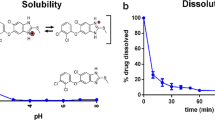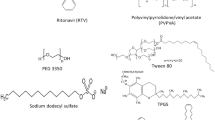Abstract
The dissolution and subsequent oral bioavailability of acyclovir (ACY) is limited by its poor aqueous solubility. An attempt has been made in this work to provide mechanistic insights into the solubility enhancement and dissolution of ACY by using the water-soluble carrier polyethylene glycol 6000 (PEG6000). Solid dispersions with varying ratios of the drug (ACY) and carrier (PEG6000) were prepared and evaluated by phase solubility, in vitro release studies, kinetic analysis, in situ perfusion, and in vitro permeation studies. Solid state characterization was done by powder X-ray diffraction (XRD), differential scanning calorimetry (DSC), and Fourier transform infrared (FTIR) analysis, and surface morphology was assessed by polarizing microscopic image analysis, scanning electron microscopy, atomic force microscopy, and nuclear magnetic resonance analysis. Thermodynamic parameters indicated the solubilization effect of the carrier. The aqueous solubility and dissolution of ACY was found to be higher in all samples. The findings of XRD, DSC, FTIR and NMR analysis confirmed the formation of solid solution, crystallinity reduction, and the absence of interaction between the drug and carrier. SEM and AFM analysis reports ratified the particle size reduction and change in the surface morphology in samples. The permeation coefficient and amount of ACY diffused were higher in samples in comparison to pure ACY. Stability was found to be higher in dispersions. The results suggest that the study findings provided clear mechanical insights into the solubility and dissolution enhancement of ACY in PEG6000, and such findings could lay the platform for resolving the poor aqueous solubility issues in formulation development.






Similar content being viewed by others
REFERENCES
Smyth HD. Recent advances in solid dispersions and the formulation of poorly absorbed drugs. Drug Dev Ind Pharm. 2016;42(3):351–2. doi:10.3109/03639045.2016.1147716.
Yohei K, Koichi W, Manabu NI, Shizuo Y, Satomi O. Formulation design for poorly water-soluble drugs based on biopharmaceutics classification system: basic approaches and practical applications. Int J Pharm. 2011;420:1–10.
Prakash K, Jieun R, Hyeongmin K, Iksoo K, Jeong TK, Hyunil K, et al. Pharmaceutical particle technologies: an approach to improve drug solubility, dissolution and bioavailability. Asian J Pharm Sci. 2014;9:304–16.
Vo CL, Park C, Lee BJ. Current trends and future perspectives of solid dispersions containing poorly water-soluble drugs. Eur J Pharm Biopharm. 2013;85:799–813. doi:10.3109/03639045.2015.1018274.
Meng F, Gala U, Chauhan H. Classification of solid dispersions: correlation to (i) stability and solubility (ii) preparation and characterization techniques. Drug Dev Ind Pharm. 2015;41(9):1401–15. doi:10.3109/03639045.2015.1018274.
Vasconcelos T, Sarmento B, Costa P. Solid dispersions as strategy to improve oral bioavailability of poor water soluble drugs. Drug Discov Today. 2007;12:1068–75.
O’Brien JJ, Campoli-Richards DM. Acyclovir. An updated review of its antiviral activity, pharmacokinetic properties and therapeutic efficacy. Drugs. 1989;37:233–309.
Arnal J, Alveraz G, Bermjo M, Amidon GL. Commentaries. Biowaiver monographs for immediate release solid oral dosage forms: acyclovir. J Pharm Sci. 2008;97:5061–73.
Shadab M, Singh GK, Ahuja A, Khar RK, Baboota S, Sahni JK, et al. Mucoadhesive microspheres as a controlled drug delivery system for gastroretention. Syst Rev Pharm. 2012;3:4–14. doi:10.4103/0975-8453.107130.
Shadab M, Ahuja A, Khar RK, Baboota S, Chuttani K, Mishra AK, et al. Gastroretentive drug delivery system of acyclovir-loaded alginate mucoadhesive microspheres: formulation and evaluation. Drug Deliv. 2011;18(4):255–64.
Deepa P, Krutika KS. Oral bioavailability enhancement of acyclovir by self-micro emulsifying drug delivery systems (SMEDDS). Drug Dev Ind Pharm. 2013;33:1318–26. doi:10.1080/03639040701385527.
Cortesi R, Esposito E. Acyclovir delivery systems. Exp Opin Drug Deliv. 2008;5:1217–30. doi:10.1517/17425240802450340.
Kushwaha A. Solid dispersion: an approach to enhance the dissolution rate of acyclovir. Int J Nov Drug Deliv Technol. 2012;2:291–6.
Peiro E, Chirio D, Carlotti ME, Spagnalo R, Trotta M. Formulation studies of microemulsions for topical applications of acyclovir. J Drug Deliv Sci Technol. 2009;19(3):191–6. doi:10.1016/S1773-2247(09)50035-4.
Attia IA, El-Gizawy SA, Fouda M, Donia AM. Influence of a niosomal formulation on the oral bioavailability of acyclovir in rabbits. AAPS Pharm SciTech. 2007;8:206–12. doi:10.1208/pt0804106.
Khattab IS, Nada A, Zaghloul AA. Physicochemical characterization of gliclazide-macrogol solid dispersion and tablets based on optimized dispersion. Drug Dev Ind Pharm. 2010;36:893–902. doi:10.3109/03639040903578734.
Biswal S, Sahoo J, Murthy PN, Giradkar RP, Avari JG. Enhancement of dissolution rate of gliclazide using solid dispersions with polyethylene glycol 6000. AAPS Pharm SciTech. 2008;9:563–70. doi:10.1208/s12249-008-9079-z.
Craig DQM. Polyethylene glycols and drug release. Drug Dev Ind Pharm. 1990;16:2501–6.
Noushin B, Mohammad Mehdi M, Simin D. The effect of PEG molecular weights on dissolution behaviour of simvastatin in solid dispersions. Iran J Pharm Res. 2013;12(Supplement):11–20.
Arias MJ, Moyano JR, Ginés JM. Study by DSC and HSM of the oxazepam-PEG 20000 and oxazepam-D-mannitol systems: application to the preparation of solid dispersions. Thermochim Acta. 1998;321:33–41. doi:10.1016/S0040-6031(98)00437-7.
Ahuja N, Katare OP, Singh B. Studies on dissolution enhancement and mathematical modeling of drug release of a poorly water-soluble drug using water-soluble carriers. Eur J Pharm Biopharm. 2007;65:26–38. doi:10.1016/j.ejpb.2006.07.007.
Newa M, Bhandari KH, Kim JA, Yoo BK, Choi HG, Yong CS. Preparation and evaluation of fast dissolving ibuprofen-polyethylene glycol 6000 solid dispersions. Drug Deliv. 2008;15:355–64. doi:10.1080/10717540801952431.
Biswal S, Sahoo J, Murthy PN. Characterisation of gliclazide-PEG 8000 solid dispersions. Trop J Pharm Res. 2009;8(5):417–24. doi:10.4314/tjpr.v8i5.48085.
Barmpalexis P, Kachrimanis K, Georgarakis E. Physicochemical characterization of nimodipine-polyethylene glycol solid dispersion systems. Drug Dev Ind Pharm. 2014;40(7):1–10. doi:10.3109/03639045.2013.789053.
Craig DQM. The mechanisms of drug release from solid dispersions in water-soluble polymers. Int J Pharm. 2002;231:131–44.
Zakeri-Milani P, Valizadeh H, Tajerzadeh H, Azarmi Y, Islambolchilar Z, Barzegar S. Predicting human intestinal permeability using single-pass intestinal perfusion in rat. J Pharm Pharm Sci. 2007;10:368–79.
Zhang Y, Huo M, Zhou J, Zou A, Li W, Yao C, et al. DD solver: an add in program for modeling and comparison of drug dissolution profiles. AAPS J. 2010;12(3):263–8. doi:10.1208/s12248-010-9185-1.
Barzegar-Jalali M, Adibkia K, Valizadeh H, Shadbad MR, Nokhodichi A, Omidi Y, et al. Kinetic analysis of drug release from nanoparticles. J Pharm Pharm Sci. 2008;11:167–77.
Ritesh F, Poornima A. Development and evaluation of lafutidine solid dispersion via hot melt extrusion: investigating drug-polymer miscibility with advanced characterisation. Asian J Pharm. 2014;9:92–106. doi:10.1016/j.ajps.2013.12.004.
Lauer ME, Siam M, Tardio J, Page S, Kindt JH, Grassmann O. Rapid assessment of homogeneity and stability of amorphous solid dispersions by atomic force microscopy—from bench to batch. Pharm Res. 2013;30:2010–22. doi:10.1007/s11095-013-1045-0.
Janga KY, Jukanti R, Velpula A, Sunkavalli S, Bandari S, Kandadi P, et al. Bioavailability enhancement of zalepelon via proliposomes: role of surface charge. Eur J Pharm Biopharm. 2012;80:347–57. doi:10.1016/j.ejpb.2011.10.010.
Janssens S, Van den Mooter G. Review: physical chemistry of solid dispersions. J Pharm Pharmacol. 2009;61:1571–86. doi:10.1211/jpp.61.12.0001.
Venkateskumar K, Parasuraman S, Gunasunderi R, Sureshkumar K, Nayak MM, Ali Shah SA, et al. Mechanistic insights into acyclovir-polyethylene glycol 20000 binary dispersions. Int J Pharm Investig. 2016 (in press).
Karolewicz B, Nartowski K, Pluta J, Górniak A. Physicochemical characterization and dissolution studies of acyclovir solid dispersions with Pluronic F127 prepared by the kneading method. Acta Pharm. 2016;66:119–28. doi:10.1515/acph-2016-0008.
Stulzer HK, Lacerda L, Tagliari MP, Silva MAS, Favere VT, Mauro Laranjeira MCM. Synthesis and characterization of cross-linked malonylchitosan microspheres for controlled release of acyclovir. Carbohydr Polym. 2008;73:490–7.
ACKNOWLEDGEMENTS
The authors acknowledge the support of CCM Duopharma Sdn Bhd and Dynapharma Sdn Bhd in providing samples of acyclovir.
Author information
Authors and Affiliations
Corresponding author
Ethics declarations
Conflict of Interest
The authors declare that they have no conflicts of interest.
Rights and permissions
About this article
Cite this article
Venkateskumar, K., Parasuraman, S., Gunasunderi, R. et al. Acyclovir-Polyethylene Glycol 6000 Binary Dispersions: Mechanistic Insights. AAPS PharmSciTech 18, 2085–2094 (2017). https://doi.org/10.1208/s12249-016-0686-9
Received:
Accepted:
Published:
Issue Date:
DOI: https://doi.org/10.1208/s12249-016-0686-9




